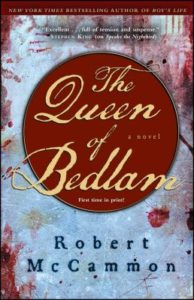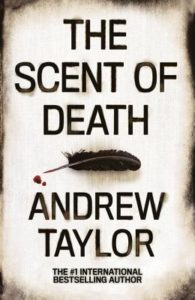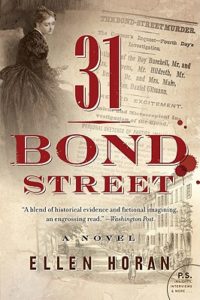Before we begin, I feel as though I ought to confess that in the flesh, I find New York City overwhelming. It’s too tall. Too crowded. Too claustrophobic and expensive and intimidating. But in fiction, like so many other things that hold little appeal for me in real life—hunting serial killers, magical quests to save faux-medieval kingdoms, relationships with dark, brooding men—New York has an irresistible allure.
And so from the moment I began working on my debut novel, A Deadly Fortune, there was never any question about where I would set it. New York City—specifically the late-19th century New York of Caroline Astor and Paul Kelly, of 5th Avenue and Five Points—was the only place for the story of Amelia Matthew, a young psychic who finds herself trapped in an insane asylum after a head injury dramatically enhances her gift.
I’m not alone in that instinct. I don’t know if anyone has crunched the numbers, but if I had to bet on which city is the setting for more novels than any other, I would put my money on New York in a heartbeat. It’s so popular a setting, in fact, that it’s possible to trace the evolution of the city through the stories set there—from its earliest beginnings as a little colonial town to the dawn of the modern metropolis. Here are ten novels—ranging from the early 18th century to the middle of the 20th, some standalones and others part of wonderful series—to get you started.

The Queen of Bedlam, by Robert McCammon
Technically the second entry in McCammon’s Matthew Corbett series, The Queen of Bedlam is the first to show us the young law clerk in his hometown of New York. It’s not New York City just yet, however, since only around 5,000 people are living there in 1703, when the events of the novel occur. Recruited by the Herrald Agency as a “problem solver,” Corbett is tasked with tracking down a masked killer stalking the streets. He realizes that to succeed, he’ll first have to uncover the identity of the titular “Queen of Bedlam,” a nameless woman living under the care of doctors in an asylum outside the city. Scenes like the one that sees Corbett riding north on horseback along Broad Way and entering the “thick woodland” on the outer edge of the town (an area just south of modern-day Canal Street), along with references to colonial politics, offer the reader a fascinating glimpse of New York City in its infancy.

The Scent of Death, Andrew Taylor
When London clerk Edward Savill arrives in New York City in the summer of 1788, he judges it “an uncomfortable provincial backwater.” A series of fires have devastated the British stronghold, and the ongoing war has sent streams of Loyalist refugees pouring into the city, all seeking aid from the Crown. Savill soon finds himself embroiled in a murder investigation, and in a city full of spies, deserters, and profiteers, it’s impossible for him to know where to turn for help. Untangling the mystery could be the key to winning the war, but trusting the wrong person could be fatal. The novel offers a fascinating portrait of New York City during the American Revolution from the British perspective.

The Gods of Gotham, Lyndsay Faye
The first installment of Faye’s Timothy Wilde trilogy follows former barman Wilde as he takes a position with the copper stars, New York City’s first organized police force. Wilde and his fellow star police, as they’re commonly known, have their work cut out for them. The city’s population has ballooned from around 60,000 at the beginning of the 19th century to nearly half a million by 1845, when the novel begins. Thousands of desperate, starving Irish immigrants are staggering off of ships every week, fleeing famine, and the city’s native residents don’t necessarily welcome their arrival. When Wilde begins investigating the murders of children—or “kinchin,” in the argot of the city’s criminal class—he runs the risk of further inflaming a city already on the edge. Faye’s vivid use of historical detail and language is nothing short of brilliant.

31 Bond Street, Ellen Horan
Horan weaves together fact and fiction in this historical mystery, which dramatizes the 1857 murder of Dr. Harvey Burdell, a well-to-do dentist with friends in both high and low places. Suspicion soon falls on his housekeeper, Emma Cunningham, though there is no hard evidence against her. Attorney Henry Clinton sets out to prove Emma’s innocence, winning her acquittal after a trial that riveted New Yorkers of the time. Media accounts of the murder and its aftermath provided Horan with a huge amount of information on which to base her novel, and it’s clear she took advantage. The novel includes a wealth of detail about New York City in the years just before the Civil War.

What the Dead Leave Behind, Rosemary Simpson
The first of Simpson’s Gilded Age Mystery series, What the Dead Leave Behind opens amidst the infamous blizzard of 1888, which killed more than 200 New Yorkers and buried the city under feet of snow. Heiress Prudence MacKenzie’s fiancé Charles is among the lost, and she’s certain it was no accident. Her father, who has recently died, ensured that Prudence would only receive her inheritance when she and Charles married. Without Charles, Prudence—and her money—remain under the control of her stepmother. Joining forces with Charles’s best friend, a former Pinkerton agent, Prudence sets out to prove Charles was murdered. Simpson paints a detailed portrait of the restraints on women of a certain social class in the late 19th century, and the details she includes about the city are evocative.

The Alienist, Caleb Carr
No list of NYC historical mysteries could be complete without the addition of Caleb Carr’s modern classic. It’s one of my all-time-favorite novels, as well as one of the biggest influences on A Deadly Fortune, which I’ve sometimes described as “The Alienist, if Sara Howard were psychic.” While seeking to solve a series of grisly murders, reporter John Schuyler Moore and controversial alienist Lazlo Kreizler, along with a pair of detectives and a secretary—the aforementioned Sara Howard—attempt a revolutionary form of investigation: building a psychological profile of their suspect and using it to track him down. The novel is legendary for the depth and breadth of detail—the New York City of 1896 is fully rendered. The detectives report on their findings over a multi-course dinner at the famous Delmonico’s, and the book features cameos by everyone from magnate John Pierpont Morgan to gangster Paul Kelly.

A Front Page Affair, Radha Vatsal
In the New York City of 1915, Capability “Kitty” Weeks is an oddity: a woman who doesn’t need to work but does so anyway. An aspiring reporter, she writes about society events for a newspaper’s Ladies’ Page. When a guest is murdered at a party she’s covering, Kitty sees an opportunity. She begins investigating the crime and uncovers the dead man’s foreign connections. The recent sinking of the Lusitania and the growing worry that the United States may be drawn into the war against Germany hang over the city, and the novel does a wonderful job of conveying the sense of a New York as a city teetering between the restrictive mores of the 19th century and the more relaxed modernity of the 20th.

A Death in Harlem, Karla FC Holloway
Set in 1927 during the height of the Harlem Renaissance, Holloway’s novel follows Harlem’s first Black policeman, Weldon Haynie Thomas, as he investigates the suspicious death of Olivia Frelon, a light-skinned socialite and newcomer to city’s Black elite. Her best friend Vera—who also happens to be the wife of Olivia’s lover—is arrested, though Thomas soon comes to have his doubts. It seems everyone has secrets, and Thomas uncovers quite a few of them as he probes for clues, unsettling powerful members of New York City’s social hierarchies—both Black and white. Holloway offers a sharply-drawn depiction of Jazz Age Harlem—both the location itself and its larger place in the history of New York City.

A Dangerous Engagement, Ashley Weaver
While the other six novels in Weaver’s Amory Ames series are set in England, A Dangerous Engagement draws Ames and her husband Milo across the Atlantic to attend the wedding of a friend. When one of the wedding party winds up dead, Amory and Milo investigate, plunging headfirst into the unfamiliar environment of 1933 New York City. Speakeasies, gangsters, and the lingering effects of the stock market crash are all in evidence throughout the novel, and the fact that the main characters are British gives Weaver an opportunity to highlight cultural differences and details about New York that would be out of place from a native narrator.

Manhattan Beach, Jennifer Egan
Manhattan Beach isn’t technically classified as a mystery novel, but main character Anna Kerrigan’s search for her missing father is one of the main plot points, so for our purposes, I’m declaring that it counts. Beginning in 1934, the novel soon jumps ahead to 1942, when Anna is taking classes at Brooklyn College and working a tedious job at the Brooklyn Navy Yard, which she abandons after becoming its first female diver, repairing ships for the war effort. The book offers a broad look at New York City under the shadow of World War II, visiting old money haunts and underworld-adjacent nightclubs, but always returning to the Brooklyn waterfront. The novel, which the New York Times says “deserves to join the canon of New York stories,” does a masterful job of portraying a city on the cusp of becoming the New York of today.
*


















